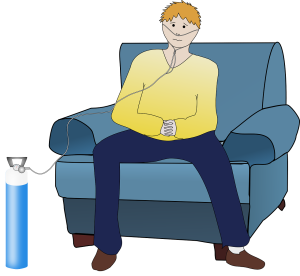
How does an Oxygen Concentrator work?
An Oxygen Concentrator uses the ambient air, which is normally 80% nitrogen and only 20% Oxygen. The oxygen concentrator separates the two components by using zeolite granules to selectively absorb nitrogen from the compressed air. The compressor raises the air pressure to about 20-lbs per square inch (P.S.I). The compressed air is introduced into one of the canisters containing zeolite granules where nitrogen is selectively absorbed leaving the residual oxygen available for patient use. After about 20 seconds the supply of compressed air is automatically diverted to the second canister where the process is repeated enabling the output of oxygen continue uninterrupted.
While the pressure in the second canister is at 20 P.S.I. the pressure in the first canister is reduced to zero. This allows nitrogen to be released from the zeolite and returned into the atmosphere. The zeolite is then regenerated and ready for the next cycle. By alternating the pressure in the two canisters so that first one and then the other is at 20 P.S.I., a constant supply of oxygen is produced while the zeolite is continually being regenerated. Individual units have an output of up to five litres per minute with an oxygen concentration of up to 95%. What is Zeolite? The word ‘zeolite’ is Greek in origin and means ‘boiling stones’ as natural zeolites visibly lose water when heated. Zeolite is an inorganic porous material having a highly regular structure of pores and chambers that allows some molecules to pass through, and causes others to be either excluded, or broken down. It is in many ways, the inorganic equivalent of organic enzymes, many of which also have specific sized chambers that trap chemicals within our bodies, holding them where they either break down, or react with specific chemicals. Zeolite has many uses.
Who uses O2 concentrators?
COPD Patients suffer from chronic obstructive pulmonary disease (COPD), an illness with disabling symptoms, high cost of care, and substantial mortality. COPD is an obstructive airway disease that is characterized by a reduction noted on the individual’s pulmonary function study. The term COPD is often applied to a family of diseases, including emphysema, chronic bronchitis, and alpha 1-antitrypsin disease. Currently, therapeutic interventions can slow the progression of these diseases, but they cannot stop or reverse it.
Oxygen concentrators dramatically extends the use time from a supply of oxygen, offering increased mobility with improved comfort and increased efficiency. The short pulse of oxygen delivered during inhalation is almost undetectable, and the humidity in the room air helps maintain a normal level of moisture in the nasal cavity. This greatly reduces the discomfort of dehydration associated with a continuous flow oxygen system.
For more information on medical oxygen, oxygen concentrators and traveling abroad please contact Oxygen Worldwide.




